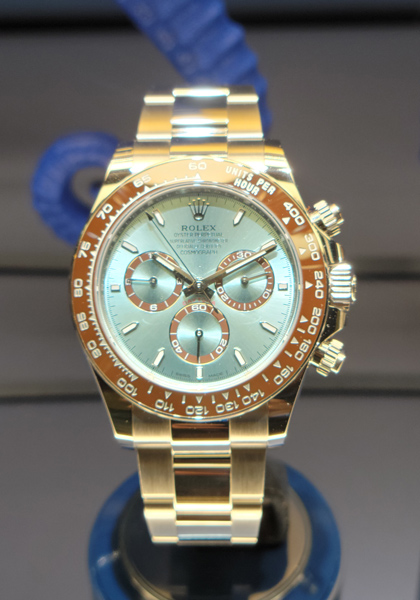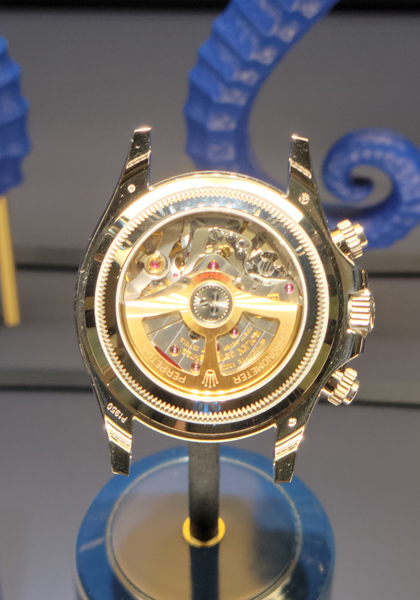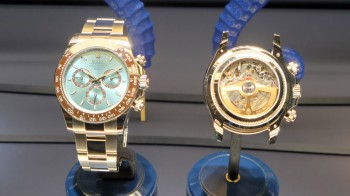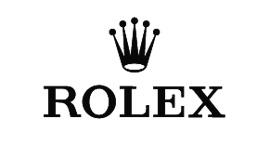Thunder in the quiet skies of watchmaking. One of the most established rules of watch manufacturing has just been broken. Rolex has updated their Daytona collection. Wait, that's not the explosion I'm talking about. Hang on to your breeches. The new full-platinum Daytona, the one with the glacier blue dial has a...wait of it...a sapphire caseback. Do you realize how big this is ? Isn't that just incredible ? What do you mean, no ? Really ? This may mean that you're not fully aware of all the subtleties in the Rolex design play-book.
Let's take stock of the breadth of this move. And that means going back in the brand's recent history. More particularly, examining their relationship with that indispensable design feature, one that's become ubiquitous at all price points : the transparent caseback.
Rolex is THE brand that made sapphire crystals a normal feature of their watches. Somewhere in the 1980s, the unscratchable and prestigious material started replacing all the mineral and glorified plastic crystals that reigned supreme, for lack of a better technology. At the beginning of the 00s, it spread to the other side of the case, onto the caseback and opened a wide, unencumbered view on the movements the world no idea were there. Borne by an unprecedented glorification of their mechanical features and complications, watches with sapphire casebacks quickly became ubiquitous... except at Rolex. They always nixed it, staying doggedly and totally faithful to the full caseback.

Totally ? There was once an exception. During the 00s, the brand launched a new collection within the Cellini family. This was then a much more varied collection of what the brand perceived as classic designs, and not-Oyster designs. The Cellini Prince ref.5440 and 5442 were historical oddities, not only because of their rectangular shape, but because of their movement features. Caliber 7040 was visible through a wide, rectangular, transparent caseback. It was also guilloché, had a small second and, hang on to your seat, was hand-wound. That one was a million miles away from what Rolex now does.
Except for that odd one out, that ended up being canceled rather quickly, Rolex made the full caseback an actual rule. Not only is it full, but it's also plain and smooth. Except for a couple of other oddities, those backs have no engraving, no printed message, not even a technical or legal one. That space was lying fallow... up until now.
Since this is the 60th anniversary of the Rolex Oyster Perpetual Cosmograph Daytona, aka the Daytona, the brand has updated it completely. New dials, new indices, new colorways, new approach to case polishing and of course, new movement. And this time, it's not just an update like they've done several times in the past, which had started with the Daytona by the way.
The Cosmograph Daytona was the first to inaugurate an entirely new generation of calibers that changed the technical face of Rolex. Some features first seen on caliber 4130 spread throughout the brand over the years. But no one ever saw it, or them, unless one could get a hold of repair pictures, or some taken by crazy geeks that had taken upon themselves to inform the public...

And yet, all-new calibre 4131 doesn't just use the new Chronergy escapement and other augmentations. For its first appearance under the limelight, it received a brand new oscillating weight. No more half-disc with rectangular openings, adorned with nice finishings but not very beautiful ones (and who cared because no one ever saw them anyway). Rolex has designed a new rotor with three arms and two wide openworked openings. On the gold, Rolesor and steel Daytonas, its bevels are gold-plated while the rest is gray. But the platinum version gets one that's altogether different.
Platinum is not just the most precious metal Rolex uses. It's always had a special status. It has an exclusive dial color (Glacier blue), an exclusive ceramic bezel color (chocolate) and an exclusive price tag (yes, it's pretty hefty). When Rolex wants to update a major feature, they generally start at the top of the range. So this new platinum Daytona has the first transparent caseback in an Oyster Rolex. The movement is gorgeous with its brand new Cotes de Genève, and get this : the rotor is made of solid yellow gold. Pardon my French, but it's all that pretty freakin' awesome ?







